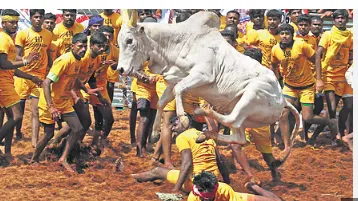

Tirupati, January 2: A Jallikattu event held as part of the Sankranti celebrations in Kotha Shanambatla village, Chandragiri Mandal, Tirupati district, left five individuals injured, according to local police. The event, which attracted participants from across the region, saw around 200 bulls brought in from Andhra Pradesh, Tamil Nadu, and Karnataka.
The traditional bull-taming sport, celebrated on the third day of Pongal (Mattu Pongal Day), involves participants attempting to tame charging bulls. Jallikattu, also known as sallikkattu, takes its name from the words Jalli (silver or gold coins) andKattu(tied), as coins are tied to the bulls' horns, and participants who successfully control the bulls can claim them as rewards.
The bulls used in the event are typically of the Pulikulam or Kangayam breed, with winning bulls highly sought after in the market for their high value. More details on the incident are awaited.